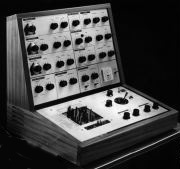

VCS3
My first close encounter with a synthesizer was when Richard Teitelbaum showed up in Rome in 1966 with one of the first models of the Moog and, as far as any one knows, the very first Moog machine to be seen in Europe. Some years before that I had known the maker Paolo Ketoff and his instrument the Synket here in Rome – a truly congenial forerunner of modern synthesizers that had a very short life – but in neither case did I run to greet these machines, as did many, as the saviors of contemporary music. On the contrary, I felt out of it, and in way even threatened by them. “Just another gimmick, they’ll be selling them in department stores before long” – all typical of a most conservative attitude, one that wished the false gods of technology a quick passage to hell.

John Eaton with Synket, Rome, 1964
The third synthesizer I came to know at the same time was a self-constructed device made by one of the founding members of MEV, Alan Bryant – but because of its ridiculous appearance (a tall triangular column dotted with holes and banana plugs) and its even more primitive circuitry and the sputtering grunts and blats it emitted, I was at least not alienated by it, simply because there was something still “human” in it.
The presence of these two instruments did not daunt the members of the early MEV group. In fact right from the beginning there was an amiable and fruitful conspiracy between these two electronic beasts and the amplified glass plate, springs, and cymbal of Frederic Rzewski, and the amplified gasoline can, thumb piano, and broken trumpet which were my own instruments, not to mention the howling tenor sax of Ivan Vandor or the amplified cello, toy piano, and various junk of John Phetteplace. We were all indeed rather proud to have these two new machines in our midst – not only to justify the word ELETTRONICA in our group’s name, but because the very boundaries which these instruments enlarged were a constant source of inspiration to those of us who made sound with more humble objects. So not only was a characteristic sound created, but a whole new attitude about sound in time was born among all of us – which led us on the one hand inside the most microcosmic detail and vibration and on the other inside the mysteries of the timeless and what subsequently seemed to be very “long” music. There were no scores, or plans, or structures, simply the sounding objects or circuitries and the people who activated them. In a word there existed, in spite of the strange marriage between the voltage control area and the totally human control dependent area, a mutual understanding, respect, general democratization.
As time went on and the group’s music became better known the whole issue of circuitry or not and all remaining doubts about Synthesizers in general became a dead issue – these electronic instruments had become part of our lives, our thinking, our music.
My personal diffidence was overcome in the early 70s, when I decided to buy a VCS3 which had just come out (with model no. 5 I was the first in Italy to have one). This machine served me well, as it became an extremely useful and efficient tool for creating instant music for theater and film which in those years was my bread and butter. It was employed very characteristically, too, in my first solo performance piece, Canti e Vedute del Giardino Magnetico (Ananda 1), and determined my own “sound” in its lyrical and minimalistic aspects. Though I had become a very proficient player of this instrument, I never really let myself become what is commonly thought of as “electronic,” and my early pieces were always grounding themselves in the use of simple and often primitive instruments (harmonica, Jew’s harp, glass chimes, plastic tubes, cow bells, piano, voice, etc.) not to mention my personal almost ubiquitous use of recorded natural sounds.

Serge
In 1978 and with much reluctance I sold my VCS3 to which I had become
very attached and replaced it with a very sophisticated Serge Modular, which
has I suppose made me officially “electronic.” It is a precision
instrument capable of truly infinite possibilities ranging from the nastiest
aleatory to the most banal kinds of sequencing, which nonetheless provide at
any moment serious complexities requiring a certain fundamental knowledge of
electronic synthesis as well as “music.” Yes the MUSIC. If it be
latent in the hollow trunk of a tree or a dried animal hide or a distant wind,
or in an electronic chip, it’s really all the same, for it’s only
the human heart and mind that can realize these sounds and transform them into
ineffable music.
Alvin Curran. February 1981

Moog system c.1970, from Moog catalog